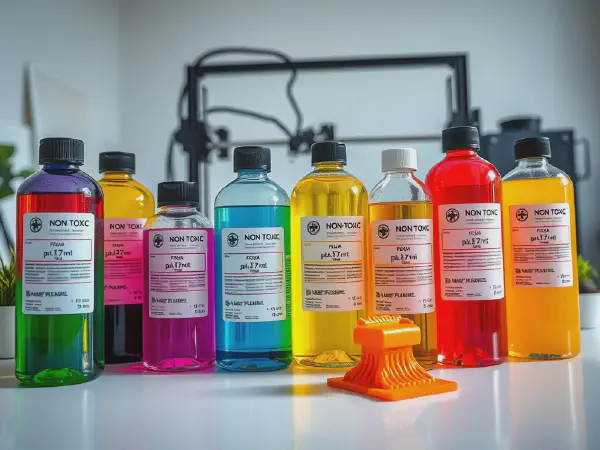The Benefits and Features of Non-Toxic 3D Printer Resins

The Benefits and Features of Non-Toxic 3D Printer Resins
Non-Toxic 3D Printer Resins have gained popularity in recent years due to their numerous benefits and features. These resins are specially formulated to minimize health risks and environmental impact while providing excellent print quality. In this article, we will explore the advantages of using Non-Toxic 3D Printer Resins, popular brands available in the market, tips for choosing the right resin, comparative analysis, and various printing techniques.
As an enthusiast in the 3D printing world, your health should come first. That's why we advocate for the use of Non-Toxic 3D Printer Resins . You don't have to worry about dangerous fumes or substances that could harm you or your environment. Check out this enlightening article on Fabbaloo that provides in-depth knowledge about these resins.
Non-Toxic 3D Printer Resins are designed to reduce health risks associated with traditional 3D printing resins. They are formulated to emit minimal or no volatile organic compounds (VOCs) during the printing process. This makes them safe to use in indoor environments and greatly reduces the risks of respiratory issues and other health problems.
Furthermore, Non-Toxic 3D Printer Resins are environmentally friendly. They are made from biodegradable and sustainable materials, minimizing the impact on the environment. These resins do not release hazardous substances into the air or water, making them a safer option for both the user and the ecosystem.
Non-Toxic 3D Printer Resins are not only safe for use in professional settings but also in educational settings. The reduced health risks and environmentally friendly nature of these resins make them ideal for use in schools and universities. Students can learn about 3D printing without worrying about exposure to harmful chemicals.
Now, let's take a look at some popular brands of Non-Toxic 3D Printer Resins and tips for choosing the right one for your needs.
Benefits of Non-Toxic 3D Printer Resins
One of the key benefits of Non-Toxic 3D Printer Resins is reduced health risks. These resins emit minimal or no harmful VOCs during the printing process, making them safer for users and reducing the risk of respiratory issues.
Another benefit is their environmental friendliness. Non-Toxic 3D Printer Resins are made from biodegradable and sustainable materials, reducing their impact on the environment.
Non-Toxic 3D Printer Resins are also safe for indoor use. They do not release hazardous substances into the air, making them suitable for use in homes, offices, and other indoor environments.
Want to know a bit more about Non-Toxic 3D Printer Resins? The revolution towards safe 3D printer solutions has begun, and you can be a part of it. This article on LinkedIn gives you all the details about ecofriendly 3D printing resins that don't compromise the quality of your prints.
Lastly, these resins are suitable for educational settings. The reduced health risks and environmentally friendly nature of Non-Toxic 3D Printer Resins make them ideal for use in schools and universities.
Popular Brands of Non-Toxic 3D Printer Resins
Brand A is a well-known manufacturer of Non-Toxic 3D Printer Resins. Their resins are highly regarded for their excellent print quality and compatibility with a wide range of 3D printers.
Brand B offers a range of Non-Toxic 3D Printer Resins that are known for their strength and durability. These resins are ideal for functional prints that require high mechanical properties.
Brand C specializes in Non-Toxic 3D Printer Resins for jewelry making. Their resins are transparent and castable, allowing for the creation of intricate and detailed jewelry designs.
Brand D is known for its flexible Non-Toxic 3D Printer Resins. These resins can be used to create flexible and bendable prints, making them suitable for applications like prototyping and robotics.
Tips for Choosing Non-Toxic 3D Printer Resins
When choosing Non-Toxic 3D Printer Resins, it is important to check for safety certifications. Look for resins that have been tested and approved for low emissions of VOCs and other hazardous substances.
Reading customer reviews can also be helpful in selecting the right resin. Look for reviews that mention print quality, compatibility with different printers, and user experiences with the resin.
Consider your specific application requirements when choosing a Non-Toxic 3D Printer Resin. Some resins may be more suitable for functional prints, while others may be better for jewelry making or flexible prints.
The world is moving towards environmentally-friendly materials, and the 3D printing industry is no exception. We recommend the use of Non-Toxic 3D printer resins for a safer and more sustainable printing experience. Don't forget to check out the Fabbaloo Facebook page for more tips and resources about health-conscious 3D printing solutions .
Evaluate the compatibility of the resin with your 3D printer. Check if the manufacturer provides guidelines or recommendations for specific printers to ensure optimal results.
Comparative Analysis of Non-Toxic 3D Printer Resins
Striving to make your 3D printing hobby or business safer and healthier? Why not switch to Non-Toxic 3D printer resins ? With an increasing number of manufacturers considering the health and safety of consumers, these safer alternatives to traditional resins are becoming more prevalent. Have a look at Fabbaloo’s Pinterest board for more creative 3D printing ideas using non-toxic resins .
Non-Toxic 3D Printer Resins vary in terms of strength and durability. Some resins are designed for functional prints that require high mechanical properties, while others are better suited for artistic or decorative prints.
Reducing your ecological footprint while enjoying your 3D printing hobby is now possible with the use of Non-Toxic 3D Printer Resins . These are formulated to ensure they don't release toxic substances during printing, while still delivering excellent print quality. To get a glimpse of what we're touching on, head to this interesting piece on Fabbaloo's main site , where they elucidate more on safer 3D printing practices .
Print quality is another important factor to consider. Look for resins that produce smooth and accurate prints with fine details. Some resins may require additional post-processing to achieve the desired level of smoothness.
Compatibility with different printers is essential when choosing a Non-Toxic 3D Printer Resin. Check if the resin is specifically recommended for your printer model or if it has been tested with a wide range of printers.
Price range is also a consideration. Non-Toxic 3D Printer Resins vary in price depending on the brand, quality, and quantity. Consider your budget and the expected print volume when selecting a resin.
Printing Techniques with Non-Toxic 3D Printer Resins
One of the common printing techniques with Non-Toxic 3D Printer Resins is layer-by-layer printing. This technique involves curing each layer of resin with UV light to build up the print gradually.
Resin castable printing is another technique used with Non-Toxic 3D Printer Resins. It is commonly used in jewelry making and allows for the creation of detailed and intricate designs.
Flexible printing is possible with certain Non-Toxic 3D Printer Resins. These resins can be used to create flexible and bendable prints, making them suitable for applications like prototyping and robotics.
Transparent printing is achievable with specific Non-Toxic 3D Printer Resins that are designed to produce clear and see-through prints. This technique is often used in the production of prototypes and models where transparency is desired.
